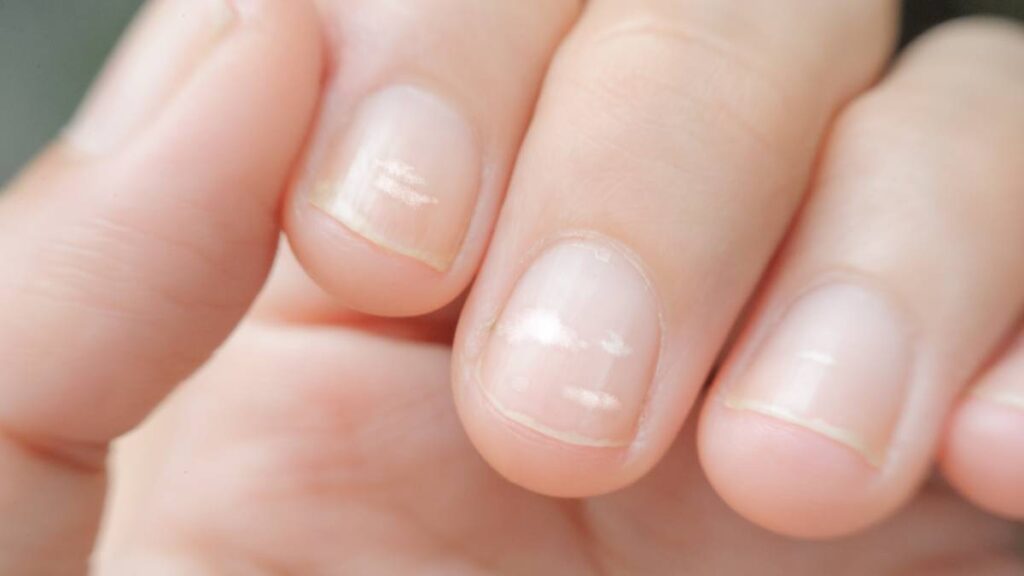Your nails can reveal clues about your overall health. Pale, pitted, ridged or discoloured nails are all usually a symptom of a bigger health problem. Liver, lung and heart problems, as well as vitamin and mineral deficiencies often show up in your nails.
So, what are you looking for? Here’s a rundown.
White or pale nails
If your nailbed is very pale or if you have white nailbeds with darker rims near the top, you might have a problem with your liver, such as hepatitis. Pale nails can be also be a sign of liver disease, anaemia, congestive heart failure or malnutrition.
Yellow nails
If you haven’t recently been cooking with turmeric then chances are your yellow nails are a fungal infection. In more serious cases, yellow nails could mean thyroid disease, lung disease, psoriasis or diabetes.
Blue nails
If your nails have a bluish tint, then you may not be getting enough oxygen, which could mean you have a lung problem such as emphysema or some type of heart problem.
Pitted nails
If the surface of your nail is rippled, pitted or has tiny dents, it may be an early sign of psoriasis or inflammatory arthritis. It could also be attributed to eczema or a range of other conditions. Basically, see your GP if your nails are pitted.
Cracked, brittle or split nails
One of the more commonly reported nail problems – rough, splitting, cracked or brittle nails – can be linked to hypothyroidism but is more often due to repeated wetting and drying of your fingernails. Called onychoschizia, this condition can easily be overcome by applying lotions, using gloves when washing dishes or working with water and keeping your hands dry. If you have cracked yellow nails, you may have a fungal infection.
Soft nails
Soft nails are usually caused by overexposure to moisture or chemicals, such as detergents, cleaning fluids or nail treatments. They could also be linked to a deficiency in B vitamins, calcium, iron or fatty acids.
Peeling nails
If your nails are peeling, it is most likely due to external trauma, such as using your nail as a tool (think screwing, scraping, scratching). It could also be an internal issue, such as iron deficiency. If your toenails are also peeling, it’s most likely internal and may require a visit to your GP or a simple diet change. If not, try wearing gloves while doing dishes – and quit using your nail as a screwdriver.
Puffy nail fold
If the skin around your nailbed seems puffy and red, you may have lupus or a connective skin disorder. It could also be caused by infection.
Dark lines underneath your nail
Dark lines beneath your nail should be checked immediately, as it can be a sign of melanoma. Black lines could also be a splinter haemorrhage most likely caused by trauma such as hitting your finger with a hammer.
Scattered white spots
Scattered white on your nail could be a sign of an allergic reaction, fungal infection or some other injury to your nail.
Horizontal ridges
Deep horizontal lines on your nails are called Beau’s lines, which could be symptoms of mumps, thyroid disease, diabetes or syphilis.
Half-moon at the base of your nail
Most people have a little white curve at the base of their fingernail. Some don’t. But if you did have them and they have disappeared, it may be a sign of malnutrition, depression or anaemia, issues with your thyroid or pituitary gland, iron deficiency, chronic renal failure, depression and possible B-12 deficiency.
If they turn red and you experience dizziness, anxiety, light-headedness, weight loss or gain or unusual cravings, you should see a doctor, as it could indicate collagen vascular disease, heart failure, chronic obstructive pulmonary disease (COPD), cirrhosis, chronic hives, psoriasis, or carbon monoxide poisoning.
Gnawed fingernails
Okay, so you may know why your fingernails are gnawed, but it could be a sign of anxiety or obsessive compulsive disorder, so you may benefit from seeing a doctor.
Changes to your nails may inform you of possible health conditions, but the key word is ‘possible’. If you have any concerns about what your nails might be telling you, see your doctor.
Have your nails ever indicated a more serious health condition? Why not share your experience in the comments section below?
Also read: Why are your toenails that colour?
Disclaimer: This article contains general information about health issues and is not advice. For health advice, consult your medical practitioner.

